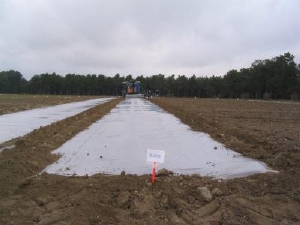May 7 2008
Methyl bromide, an odorless, colorless gas used as an agricultural pesticide, was introduced in the 1980s as an effective way to control weeds and increase fruit yields. Agricultural production nurseries around the world relied on methyl bromide (MB) to produce healthy plants for export and domestic sales. In 2000, the widely used pesticide was classified as an ozone-depleting substance, and in 2005 MB was banned in the United States and all European Union countries.
 Researchers study new methods of weed control in strawberry nurseries. (Credit: Eva Garcia)
Researchers study new methods of weed control in strawberry nurseries. (Credit: Eva Garcia)
In response to the need for safe and effective alternatives to methyl bromide, researchers at the Instituto Tecnologico Agrario de Castilla y Leon in Valladolid, Spain, undertook a 3-year project to study new methods of weed control in strawberry nurseries. Results of the comprehensive research project were published in the February 2008 issue of HortScience.
According to lead researcher Eva García-Méndez, "the phaseout of methyl bromide requires effective alternatives for soil disinfestation, particularly in high-elevation strawberry nurseries." In the study, MB alternatives were evaluated for weed control and plant yields at strawberry nurseries participating in Spain's Methyl Bromide Alternatives Project (INIA). Two types of field trials were carried out: replicated experiments and commercial-scale field demonstrations.
In the replicated experiments eight fumigant treatments were evaluated each year, including the nonfumigated control and commercial standard methyl bromide plus chloropicrin mixture. Other treatments evaluated included: dazomet, chloropicrin alone, metam sodium plus chloropicrin, chloropropene:chloropicrin, DMDS plus chloropicrin, and propylene oxide. The best alternative treatments from the replicated experiments were then tested in the demonstration phase of the project.
The researchers discovered that several of the chemical alternatives they evaluated controlled weeds as consistently as MB, but all of the alternatives studied were less consistent than MB in terms of plant yields. They also found that the use of some types of barrier films increased the performance and consistency of alternative pesticides and that environmental factors such as weather, soils, and rotational crops contributed to inconsistencies in weed control and runner yields at high-elevation nurseries.
In summary, García-Méndez stated: "Replacements for methyl bromide will require more than one fumigant component as well as a higher level of management of pest populations in the fields during rotational crop production. It is necessary to continue evaluation of alternative fumigants for strawberry nurseries to focus on commercial field-scale demonstrations. Moreover, European Union regulatory restrictions may require the use of non-chemical alternatives in the near future. The need for evaluations of chemical and non-chemical soil disinfestation methods is urgent."
The complete study and abstract are available on the ASHS HortScience electronic journal web site: http://hortsci.ashspublications.org/cgi/content/abstract/43/1/177